 W
WAngel Island is an island in San Francisco Bay. The entire island is included within Angel Island State Park, administered by California State Parks. The island, a California Historical Landmark, has been used by humans for a variety of purposes, including seasonal hunting and gathering by indigenous peoples, water and timber supply for European ships, ranching by Mexicans, United States military installations, a United States Public Health Service Quarantine Station, and a U.S. Bureau of Immigration inspection and detention facility. The Angel Island Immigration Station, on the northeast corner of the island, which has been designated a National Historic Landmark, was where officials detained, inspected, and examined approximately one million immigrants, who primarily came from Asia. Under the Chinese Exclusion Act of 1882, the first United States law to restrict a group of immigrants based on their race, nationality, and class, all arriving Chinese immigrants were to be examined by immigration or customs agents.
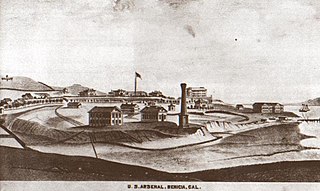 W
WThe Benicia Arsenal (1851–1964) and Benicia Barracks (1852–66) were part of a large military reservation located next to Suisun Bay in Benicia, California. For over 100 years, the arsenal was the primary US Army Ordnance facility for the West Coast of the United States.
 W
WCamp Babbitt was an American Civil War Union Army camp located in two sites in the vicinity of Visalia, California.
 W
WCamp Butler National Cemetery is a United States National Cemetery located a few miles northeast of Springfield and a few miles southwest of Riverton, a small town nearby to Springfield, in Sangamon County, Illinois. It was named for Illinois State Treasurer at the time of its establishment, William Butler. Administered by the United States Department of Veterans Affairs, it occupies approximately 53 acres (21 ha), and is the site of 19,825 interments as of the end of 2005. Camp Butler National Cemetery was placed on the National Register of Historic Places in 1997.
 W
WCamp Chase was a military staging and training camp established in Columbus, Ohio in May 1861 after the start of the American Civil War. It also included a large Union-operated prison camp for Confederate prisoners during the American Civil War.
 W
WCamp Curtin was a major Union Army training camp in Harrisburg, Pennsylvania, during the American Civil War. It was located north of Pennsylvania's state capitol building on 80 acres of what had previously been land used by the Dauphin County Agricultural Fairgrounds.
 W
WIn mid-May 1861, U. S. Navy lieutenant William "Bull" Nelson armed Kentuckians loyal to the Union and that soon became the foundation for his receiving authority to enlist 10,000 troops for a campaign into East Tennessee. On August 6, 1861, those recruits marched into Camp Dick Robinson, making it the first Federal base south of the Ohio River. For Col. George C. Kniffen, "the wisdom of President Lincoln commissioning. .. Nelson to organize a military force on the [neutral] soil of Kentucky" prevented making the state a "battle ground for many months" and it thereby changed the whole direction of the war. In 1864, Salmon P. Chase declared in a speech at Louisville "when Kentucky faltered, hesitated" in the early stages of the Civil War, that undecided "status was settled by WILLIAM NELSON, at Camp Dick Robinson." Six years later, Indiana Senator Daniel D. Pratt reported to the U. S. Senate that Camp Dick Robinson "was one of the most noted military encampments of the war.. .. From its admirable locality and advantages, it was almost indispensable for the successful operations of the" Civil War.
 W
WCamp Douglas, in Chicago, Illinois, sometimes described as "The North's Andersonville," was one of the largest Union Army prisoner-of-war camps for Confederate soldiers taken prisoner during the American Civil War. Based south of the city on the prairie, it was also used as a training and detention camp for Union soldiers. The Union Army first used the camp in 1861 as an organizational and training camp for volunteer regiments. It became a prisoner-of-war camp in early 1862. Later in 1862 the Union Army again used Camp Douglas as a training camp. In the fall of 1862, the Union Army used the facility as a detention camp for paroled Confederate prisoners.
 W
WCamp Floyd State Park Museum is a state park in the Cedar Valley in Fairfield, Utah, United States. The park is includes Camp Floyd, the Stagecoach Inn, and the Fairfield District School.
 W
WCamp Ford was a POW camp near Tyler, Texas, during the American Civil War. It was the largest Confederate-run prison west of the Mississippi. Summary Executions of Local Citizens, Recounted by 49th Ohio prisoners at Camp Ford: From "Twenty Months in the Dept of the Gulf", A.G.H. DuGanne "Among the last-mentioned local events, however, was the "Match Plot," which deserves a paragraph".
 W
WCamp Grant is a ghost town in Humboldt County located on the South Fork Eel River 2 miles (3.2 km) northeast of Weott and 3 miles (4.8 km) east of Dyerville. It was originally settled by Northern Sinkyone people, followed by a Union Army camp and later a logging and railroad support settlement for the construction of the Northwestern Pacific Railroad.
 W
WThe Camp Harlan-Camp McKean Historic District, also known as the Hugh B. and Mary H. Swan Farmstead and the Springdale Stock Farm, is a nationally recognized historic district located northwest of Mount Pleasant, Iowa, United States. It was listed on the National Register of Historic Places in 2013. At the time of its nomination it consisted of eight resources, which includes two contributing buildings, one contributing site, one contributing object and four non-contributing buildings.
 W
WCamp Henderson was a military outpost in the District of Oregon in 1864, built on Crooked Creek about five miles from where it joins the Owyhee River, 330 miles from Walla Walla. The camp was located at the foot of cliffs on the east side of the valley south of an historical marker located along the highway about six miles east of Burns Junction, Oregon.
 W
WCamp Joe Holt was a Union base during the American Civil War in Jeffersonville, Indiana, across the Ohio River from Louisville, Kentucky, on land that is now part of Clarksville, Indiana, near the Big Eddy. It was a major staging area for troops in the Western Theatre of the War, in preparation for invading the Confederate States of America. Its establishment was the first major step performed by Kentucky Unionists to keep Kentucky from seceding to the Confederacy.
 W
WCamp Lincoln, in Crescent City, California, was a United States military post. It was established June 13, 1862, by the men of Company G, 2nd Regiment, Infantry, California Volunteers to keep peace between the Tolowa tribe of Native Americans and the miners and settlers of northwestern California.
 W
WCamp Mather-Camp Logan is a Civil War campsite located along Illinois Route 13 outside of Shawneetown, Illinois. The campsite was Henry and Mary Eddy's farm and summer home; Henry died in 1849, leaving Mary in charge of the farm at the outset of the war. The Union Army began camping on the property in December 1861, when the 56th Illinois Infantry occupied the land; the camp was named Camp Mather for Illinois adjutant general Thomas S. Mather. The camp, part of the Department of the Ohio, was one of two Union campsites near Shawneetown, the other being Camp Katie Yates. The farm's summer home became the camp hospital and was used to treat measles patients during an outbreak in the winter of 1861-62 that killed eight soldiers. By the fall of 1862, when the 87th Illinois Infantry occupied the camp, the camp was known as Camp Logan. The soldiers of the 87th Infantry went without pay for several months while awaiting assignment and transport at the camp, and two companies nearly mutinied due to the situation. The 87th Infantry left the camp for Memphis, Tennessee, in March 1863, marking the end of Union occupation of the site.
 W
WCamp McClellan is a former Union Army camp in the U.S. state of Iowa that was established in Davenport in August 1861 after the outbreak of the American Civil War. The camp was the training grounds for recruits and a hospital for the wounded. In 1863 it became a prison camp called Camp Kearney for members of the Sioux, or Dakota, tribe that were involved in raids in Minnesota. The camp was decommissioned after the release of the prisoners in 1866.
 W
WCamp McGarry was a U.S. military camp located in what is now the Summit Lake Indian Reservation in Humboldt County, Nevada.
 W
WCamp Misery, located off the bank of the Rappahannock River, was a Union Camp established in 1861. It was originally known as Camp Butler, but earned the name Camp Misery because of the horrific winter in 1862 that the soldiers experienced.
 W
WCamp Moore, north of the Village of Tangipahoa near Kentwood, Louisiana, was a Confederate training base and principal base of operations in eastern Louisiana and southwestern Mississippi. The base was named for Louisiana Governor Thomas Overton Moore. It operated from May 1861 to 1864 during the American Civil War. Confederate monuments were erected at the cemetery and on the grounds in the early 20th century.
 W
WCamp Morton was a military training ground and a Union prisoner-of-war camp in Indianapolis, Indiana, during the American Civil War. It was named for Indiana governor Oliver Morton. Prior to the war, the site served as the fairgrounds for the Indiana State Fair. During the war, Camp Morton was initially used as a military training ground. The first Union troops arrived at the camp in April 1861. After the fall of Fort Donelson and the Battle of Shiloh, the site was converted into a prisoner-of-war camp. The first Confederate prisoners arrived at Camp Morton on February 22, 1862; its last prisoners were paroled on June 12, 1865. At the conclusion of the war, the property resumed its role as the fairgrounds for the Indiana State Fair. In 1891 the property was sold and developed into a residential neighborhood known as Morton Place, a part of the Herron-Morton Place Historic District.
 W
WCamp Nelson National Cemetery is a United States National Cemetery located in southern Jessamine County, Kentucky. It was originally a graveyard associated with the U.S. Army's Camp Nelson, which was active during the U.S. Civil War and its aftermath. The camp was named for Major General William "Bull" Nelson, commander of the Civil War Army of Kentucky, who was murdered by a fellow officer in 1862.
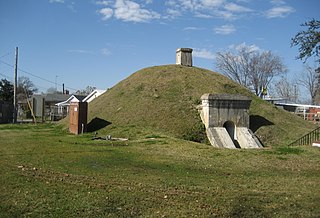 W
WCamp Parapet was a Civil War fortification at Shrewsbury, Jefferson Parish, Louisiana, a bit more than a mile upriver from the current city limits of New Orleans.
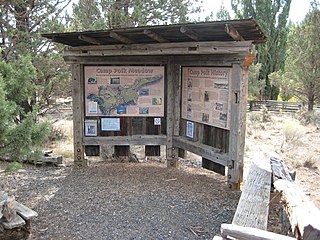 W
WCamp Polk was a former army camp in the U.S. state of Oregon that was established in Deschutes County in 1865. It was a post of the District of Oregon. One of nine camps created during a time of conflict between settlers and Native Americans, it was located three miles northeast of the present-day city of Sisters. The camp was intended to house troops who would protect settlers on the Santiam Wagon Road from Indian attack. Part of Company A, a group of volunteer soldiers from the Willamette Valley under the command of Captain Charles La Follette, were stationed at the post. The camp was named for Polk County, which was the home of most of the soldiers and their captain. No attacks occurred, and the troops received orders before winter in 1865 to leave the camp. A portion of the troops remained at the post until the spring of 1866 when Camp Polk was abandoned.
 W
WCamp Randall is a historic U.S. Army site in Madison, Wisconsin, named after Wisconsin governor Alexander Randall, who served from 1858 to 1861. It was a training facility of the Union army during the Civil War, where more than 70,000 recruits were trained. The army also established a hospital and prisoner-of-war camp here.
 W
WCamp Union was a military training center for the Union Army during the American Civil War. Constructed near Philadelphia, Pennsylvania, the camp operated from 1861 until 1865, and primarily served various Pennsylvania volunteer regiments.
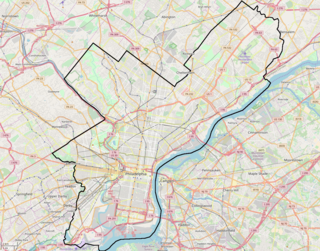 W
WCamp William Penn was a Union Army training camp located in Cheltenham Township, Pennsylvania from 1863 to 1865, notable for being the first training ground dedicated to African American troops who enlisted in the United Army during the American Civil War. Some 11,000 free blacks and escaped slaves were trained here, including 8,612 from Pennsylvania, the most black troops recruited during the war from any northern state.
 W
WOak Grove Butterfield Stage Station is located in the western foothills of the Laguna Mountains, in northern San Diego County, California. It is located on State Route 79, 13 miles (21 km) northwest of Warner Springs and Warner's Ranch. The station was built on the site of Camp Wright, an 1860s Civil War outpost.
 W
WCarlisle Barracks is a United States Army facility located in Carlisle, Pennsylvania. The site of the U.S. Army War College, it is the nation's second-oldest active military base. The first structures were built in 1757, during the French and Indian War between Great Britain and France in the colonies.
 W
WCamp Dennison was a military recruiting, training, and medical post for the United States Army during the American Civil War. It was located near Cincinnati, Ohio, not far from the Ohio River. The camp was named for Cincinnati native William Dennison, Ohio's governor at the start of the war.
 W
WThe Drum Barracks, also known as Camp Drum and the Drum Barracks Civil War Museum, is the last remaining original American Civil War era military facility in the Los Angeles area. Located in the Wilmington section of Los Angeles, near the Port of Los Angeles, it has been designated as a California Historic Landmark, a Los Angeles Historic Cultural Monument and has been listed on the National Register of Historic Places. Since 1987, it has been operated as a Civil War museum that is open to the public.
 W
WFort Anderson or Camp Anderson, was a military post first established in May 1862 by California Volunteers during the Bald Hills War. It was located on Redwood Creek, below its confluence with Minor Creek, between Fort Humboldt and Fort Gaston. It was abandoned in the winter of 1862, but reestablished in 1864 and finally closed in 1866.
 W
WCamp Douglas was established in October 1862, during the American Civil War, as a small military garrison about three miles east of Salt Lake City, Utah, to protect the overland mail route and telegraph lines along the Central Overland Route. In 1878, the post was renamed Fort Douglas. It was officially closed in 1991 pursuant to BRAC action and most of the buildings were turned over to the University of Utah. A small section of the original fort is still used by the U.S. Army Reserve and includes the Fort Douglas Military Museum. The fort was designated a National Historic Landmark in 1975, for its role in the Civil War and in furthering the settlement of Utah.
 W
WFort Independence, originally named Camp Independence, was a fort located in the Owens Valley, 3 miles (4.8 km) north of present-day Independence, Inyo County, eastern California. The U.S. Army post was active from 1862 to 1877.
 W
WFort McDermit was an U.S. Army fort in Nevada. It was established on August 14, 1865, by Captain J. C. Doughty, of Company I of the 2nd Regiment California Volunteer Cavalry, on orders of Lt. Col. Charles McDermit, Commander, Military District Nevada, as the Quinn River Camp No. 33. It was located near Quinn River Station on the East Fork of the Quinn River.
 W
WFort Miller is a former fort on the south bank of the San Joaquin River in what is now Fresno County, California. It lay at an elevation of 561 feet. The site is now under Millerton Lake, formed by the Friant Dam in 1944. It is registered as California Historical Landmark #584.
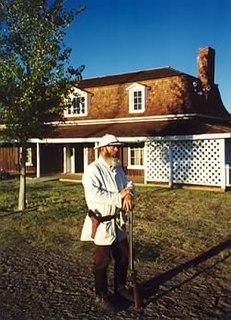 W
WFort Verde State Historic Park in the town of Camp Verde, Arizona is a small park that attempts to preserve parts of the Apache Wars-era fort as it appeared in the 1880s. The park was established in 1970 and was added to the National Register of Historic Places a year later.
 W
WIaqua is a former settlement in Humboldt County, California. It was located 5.5 miles (8.9 km) south of Kneeland.
 W
WCamp Lapwai was a United States Army encampment in Washington Territory, present-day Idaho. It was established by Company E, 1st Regiment Washington Territory Volunteer Infantry. After being mustered in at Alcatraz at San Francisco, California, they were ordered on October 19, 1862, to Camp Lapwai near the Nez Perce Agency. Joined there at the beginning of November by Company "F", 1st Oregon Volunteer Cavalry Regiment, they built the encampment. Camp Lapwai was renamed Fort Lapwai in 1863; the new Idaho Territory was also established in 1863.
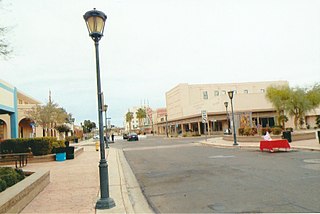 W
WThis is a list of historic properties in Yuma, Arizona, which includes a photographic gallery of some of the remaining historic structures and monuments. Yuma is the county seat of Yuma County, Arizona, United States. It is located in the southwestern corner of the state. Yuma is the site of one of the few National Historic Landmarks in the Southwest. Included in this list are photographs of some of the structures within the Yuma Downtown Historic District, the Yuma Quartermaster Depot, which today is a state historic park and the Yuma Territorial Prison a Yuma landmark.
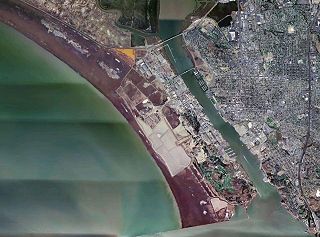 W
WMare Island is a peninsula in the United States in the city of Vallejo, California, about 23 miles (37 km) northeast of San Francisco. The Napa River forms its eastern side as it enters the Carquinez Strait juncture with the east side of San Pablo Bay. Mare Island is considered a peninsula because no full body of water separates this or several other named "islands" from the mainland. Instead, a series of small sloughs cause seasonal water-flows among the so-called islands. Mare Island is the largest of these at about 3.5 miles (5.6 km) long and a mile wide.
 W
WNewport Barracks was a military barracks on the Ohio River, across from Cincinnati, Ohio in Newport, Kentucky. It was operational from 1803 until 1894.
 W
WOak Grove Butterfield Stage Station is located in the western foothills of the Laguna Mountains, in northern San Diego County, California. It is located on State Route 79, 13 miles (21 km) northwest of Warner Springs and Warner's Ranch. The station was built on the site of Camp Wright, an 1860s Civil War outpost.
 W
WThe Pentagon Barracks, also known as the Old United States Barracks, is a complex of buildings located at the corner of State Capitol Drive and River Road in Baton Rouge, Louisiana, in the grounds of the state capitol. The site was used by the Spanish, French, British, Confederate States Army, and United States Army and was part of the short-lived Republic of West Florida. During its use as a military post the site has been visited by such notable figures as Zachary Taylor, Lafayette, Robert E. Lee, George Custer, Jefferson Davis, and Abraham Lincoln.
 W
WSan Juan Island National Historical Park, also known as American and English Camps, San Juan Island, is a U.S. National Historical Park owned and operated by the National Park Service on San Juan Island in the state of Washington. The park is made up of the sites of the British and U.S. Army camps during the Pig War, a boundary dispute over the ownership of the island. The camp sites were designated a National Historic Landmark in 1961, and listed on the National Register of Historic Places in 1966. The park was created by an act of Congress in 1966 and expanded slightly in 2013.
 W
WTrinidad is a seaside city in Humboldt County, located on the Pacific Ocean 8 miles (13 km) north of the Arcata-Eureka Airport and 15 miles (24 km) north of the college town of Arcata. Situated at an elevation of 174 feet (53 m) above its own North Coast harbor, Trinidad is one of California's smallest incorporated cities by population. Trinidad is noted for its spectacular coastline with ten public beaches and offshore rocks, part of the California Coastal National Monument, of which Trinidad is a Gateway City. Fishing operations related to Trinidad Harbor are vital to both local tourism and commercial fishery interests in the region.
 W
WYuma Quartermaster Depot State Historic Park, formerly Yuma Crossing State Historic Park, and now one of the Yuma Crossing and Associated Sites on the National Register of Historic Places in the Yuma Crossing National Heritage Area. It is an Arizona state park in the city of Yuma, Arizona, US.